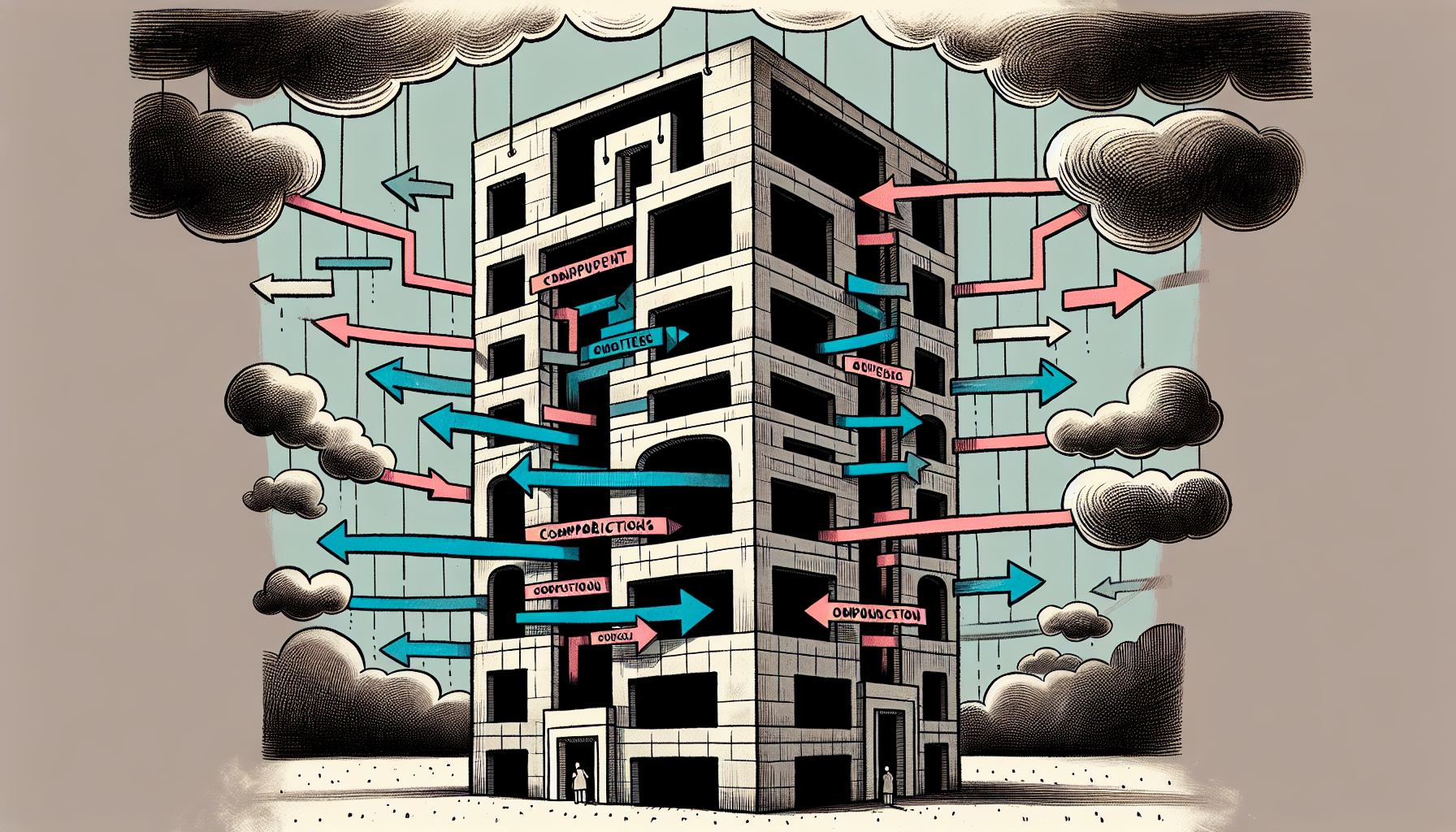Is your business suffering from poor team communication? Silos lead to inefficiencies and no collaboration, ultimately stifling innovation. This article will give you practical strategies to help you break down the silos and build a more connected and agile business.
Takeaways
Silos create barriers to communication and collaboration, innovation and overall business performance.
Key ways to break down silos are cross functional teams, unified communication tools and a collaborative company culture.
Fire Power Seminars can help your team to recognize and overcome silo mentality, unity and business success!
What are Silos and Silo Mentality in Organizations

Organizational silos are like invisible walls that separate different departments in a business, creating barriers to collaboration, communication and innovation. Silos occur when teams work in isolation, often due to hierarchical structures or over specialization, which can block the flow of information. Imagine each department speaking their own language, with little understanding of the others goals or challenges. This scenario not only stops progress but creates a counter productive ‘us versus them’ mentality.
When different departments have their own objectives these can sometimes conflict with the overall organization’s goals, leading to inefficiencies and missed opportunities. The focus moves from collective success to individual achievement, undermining the overall business mission. Silos are particularly prevalent in large organizations where communication gaps can grow wider, making it even harder to align efforts and resources towards a unified vision.
And silos can stifle growth and innovation. Poor communication and lack of awareness of other departments’ activities perpetuate silos, trapping valuable information within departmental boundaries. This slows down decision making and prevents organizations from responding quickly to market changes and customer needs.
Breaking down silos is key to a cohesive and agile company culture. Recognizing the roots and impact of silos means organizations can take proactive steps to prevent them and create an environment where collaboration and innovation can flourish.
Recognizing Silo Mentality
Recognizing the signs of silo mentality is the first step to addressing it. One of the most obvious indicators is limited communication between departments. When teams develop their own processes and workflows independently, misunderstandings and mistakes happen more often. Lack of communication can lead to inefficiencies especially when software silos create additional barriers to information sharing.
Another red flag is the ‘us versus them’ mentality where departments see each other as competitors not collaborators. This unnecessary competition creates tension and conflict and a hostile work environment. Miscommunication, duplicated work and team competition are common symptoms of this mindset.
When different teams and individual teams are unaware of each other and other teams despite interdependent work is key. This disconnection can block workflows and unaligned vision and ultimately slow down the overall business. Employees with a silo mentality will hoard information and ideas even when sharing would benefit the business.
Decentralized decision making further fragments choices and misaligns them with the business goals. Recognizing these signs early means organizations can take corrective action and create a more collaborative environment.
Fire Power Seminars as your Team Unity Provider
Is there silo mentality in your organization? Fire Power Seminars can be your answer. We know how individuals fit together to create a strong empowered team. Our seminars show participants how their personal values and beliefs impact their behavior and the team’s results, and how to overcome limiting beliefs and fixed mindsets.
Imagine a leadership team that not only understands these dynamics but works actively to integrate them into the company culture. Join our seminars and your teams will develop a deeper sense of unity and collaboration beyond their own team and break down the barriers created by silos.
Ready to see your business flourish? Join us and ignite your team!
The Impact of Silos on Business

Silos can destroy business performance. Departmental silos can prevent a company from delivering value to customers. When teams won’t share information between divisions, such as when the sales team works independently, organizational efficiency takes a hit. Silo mentality can mean inefficient operations, mistrust, low motivation, missed opportunities and even collapse.
And silos restrict efficiency and innovation. Poor communication across departments means some teams are using outdated or incorrect information, compounding errors and slowing progress. Misaligned goals between teams means duplicated work and overall progress is hindered. Organizations that don’t address silos will have low employee morale and a negative customer experience.
Not addressing silos has severe consequences. Communication barriers make issues worse and customer experiences inconsistent and profitability complicated. Breaking down silos means more efficient operations, higher employee morale and better customer satisfaction all essential to achieving business goals.
How to Break Down Silos

So how can organizations break down silos? The answer lies in implementing strategies that promote collaboration and information sharing across departments to collaborate effectively. Communicating a single vision across the entire organization is key to this. Developing shared goals across departments will help align efforts and resources.
Cross functional teams and unified communication tools are the first steps to breaking down silos. Stronger inter departmental relationships across multiple departments means cohesive joint working, mutual trust and open information sharing. Joint training enables organizations to combine their resources and expertise and tackle complex issues more efficiently and effectively.
Let’s look at these strategies and how they can work for you.
Get Leadership Buy-in
Getting leadership buy-in is key to breaking down silos. The organization needs to create and communicate a single vision to all. When managers don’t believe in this vision it can impact their team’s perception and engagement. So the leadership team must be absolutely committed to the organization’s long term goals.
Shared KPIs align departmental goals and promote collaboration. This means teams work together towards common objectives and have free and efficient information flow.
Cross Functional Teams
Cross functional teams are a powerful way to break down silos. Understanding the roles and functions of different departments, including the development team, means effective collaboration. Regular cross departmental meetings means understanding and cooperation between teams reduces silo effects.
Building trust is key. Getting to know other departments means proper involvement and support. Face to face interactions even with remote colleagues builds rapport and strengthens relationships. Creating dynamic work environments and processes together breaks down silos in cross functional teams.
Cross collaboration between teams means a more efficient workforce. This brings together diverse perspectives and project management and overall productivity in large organizations.
Unified Communication Tools for a Unified Vision
Unified communication tools are key to breaking down silos. Integrated business tools means information sharing and collaboration between teams is streamlined. Clear communication practices means no confusion and team members are aligned to project goals.
Standardizing technology across departments means cross functional communication and collaboration. These tools mean information can be shared seamlessly with no barriers or inefficiencies. A single vision with the right communication tools means teams can collaborate and achieve common goals.
A Collaborative Organization

A collaborative organization is key to long term success. The silo mentality can reduce organizational efficiency and damage the overall company culture. Employees will feel disenfranchised if they don’t feel part of a team and will lose motivation.
Trust is key in collaborative environments. Employees should feel safe to share their ideas and know their contributions are valued. Common goals means team efforts are aligned and shared responsibility. Leadership support is critical; management must model collaborative behavior to inspire and encourage team culture.
Team building activities means employees bond and build trust, collaboration is easier. Joint training sessions means exchange of diverse perspectives, understanding and communication between participants. Continuous employee connections means a culture of shared learning and networking which is key to breaking down silos.
A collaboration culture means team working, employees can rely on each other, more productivity and innovation. Autonomy and the right tools means engagement and motivation in collaborative teams.
Training and Development
Training and development is key to collaboration. Joint training sessions means inter departmental bonding and cooperation. These sessions mean understanding and a sense of belonging between employees from different departments.
Team training and collaboration means relationships are stronger. They mean more productivity and better knowledge retention. Investing in training and development means a more cohesive and collaborative workforce.
Using Technology for Better Collaboration
Technology is key to collaboration. Physical and virtual collaborative spaces means team working and project continuation across locations. Integrated technology tools means communication and project management means a collaborative work environment.
Digital tools means real time communication, project coordination across teams. Centralized data sharing means no information silos. Collaboration platforms means workflows are streamlined, meaning diverse teams can work together.
Digital tools means all team members can see the project and be aligned and informed. Virtual brainstorming tools means creative collaboration, breaking down the distance barriers. Using technology well means teams can collaborate differently and work towards common goals.
Informal Connections

Informal connections means team collaboration. Regular team building activities means departments connect on a personal level, breaking down physical and psychological barriers. Casual team events means professional relationships are strengthened by employees connecting outside of work.
Informal get togethers means open dialogue between team members, means communication. Fun activities means morale and overall job satisfaction. Leaders who participate in team building events set the tone and build stronger relationships with their team.
Quick team building activities can improve communication, morale and energy among teams, benefitting both new and existing employees. These interactions promote teamwork and the essential sharing of goals together.
Monitoring and Sustaining
Monitoring and sustaining means breaking down silos. Departments can get so focused on their tasks they forget the bigger picture and major problems will arise. Feedback loops means identifying and addressing communication bottlenecks that block collaboration.
36% of people have experienced lost and missing files due to team communication issues. Monitoring efforts to break down silos means progress and collaboration between departments. Sustained effort means momentum and silos won’t reform.
Empower Your Team with Fire Power
Light the fire in your team and look through the silos! Fire Power Seminars can help. Our programs means teams can collaborate and be at their best. We help leadership teams and employees to have one vision and work towards common goals.
Attend our seminars and get the tools and strategies to break down silos and a collaborative company culture. See how we can empower YOU.
Conclusion
Breaking down silos means a collaborative and innovative company culture. By understanding and addressing the silo mentality, organizations can improve communication, morale and business performance. Means securing leadership buy in, cross functional teams and using technology means teams can work differently.
In summary, breaking down silos means a whole of approach means leadership commitment, communication and monitoring. Ready to see your organization thrive? Take action now and create a culture where collaboration and innovation can happen.
FAQs
What are the main causes of silo mentality in organizations?
Silo mentality is mainly caused by hierarchical structures, over specialization and lack of communication! Breaking down these barriers means a more collaborative and successful organization!
How do I know if my organization has a silo mentality?
You can see a silo mentality in your organization by limited communication between departments, an us versus them attitude and lots of duplicated work! If you see these signs, it’s time to break down those barriers and collaborate!
What role does leadership play in breaking down silos?
Leadership means breaking down silos by having one vision, setting common goals and fostering collaboration! When leaders embody these behaviors they inspire teamwork and a more connected organization!
How can technology help break down silos?
Yes! Technology can break down silos by means of integrated tools for real time communication and centralized data sharing, making teamwork easy!
What are the benefits of joint training and development programs?
Joint training and development programs means inter departmental bonding and overall productivity and knowledge retention! It’s a great way to unite teams and a sense of belonging.



